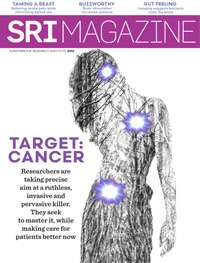Quick thyroid cancer diagnosis brings relief
Ultrasound imaging technique shortens nerve-wracking wait

Carly McCready is cancer free after being diagnosed with papillary thyroid cancer. She is a patient of Dr. Kevin Higgins, a head and neck specialist at Sunnybrook’s Odette Cancer Centre.
Photo credit: Courtesy of Carly McCready.
Carly McCready was working at Sunnybrook’s Odette Cancer Centre on a co-op term from the University of Waterloo as a genetic counseling assistant in January 2014 when one of the physicians approached her to ask if she had seen her family doctor about a noticeably large nodule that was protruding on her neck near her thyroid—the butterfly shaped organ located at the base of the neck in front of the throat that releases hormones to regulate metabolism, body weight, cholesterol levels and heart rate.
“I had it tested [two years] before and it came back negative,” says McCready, age 24. “So I called my family doctor and got a referral to Sunnybrook’s head and neck clinic.” McCready met Dr. Kevin Higgins, a head and neck surgical oncologist at Sunnybrook’s Odette Cancer Centre. He specializes in performing thyroid biopsies using 2-D ultrasound imaging, a technique that allows him to assess the lymph nodes and thyroid to determine whether a patient needs a biopsy. Higgins recently co-authored a large Canadian study that concluded surgeons are capable of performing ultrasound-guided fine-needle aspiration of the thyroid in the clinic. Read the full story here.
The minimally invasive procedure took less than 30 minutes. During her appointment, Higgins used ultrasound to locate the nodule on her thyroid. He then took a fine needle to aspirate a sampling of cells, a practice similar to drawing blood. The cells from the nodule were sent to the pathologist, and results came back in about a week. “I didn’t expect to have action taken so soon. You [usually] have to go for tests and come back. [The process] can take months, and there’s always anxiety waiting in-between appointments,” says McCready. “I was pleasantly surprised that the first day I met Dr. Higgins I had an ultrasound and biopsy. The next time I had an appointment, I had the information right away.”
McCready was diagnosed with papillary thyroid cancer, the most common type. It represents 85% of all thyroid cancer cases. Higgins and McCready decided to remove surgically the right lobe of the thyroid. It was not until the final pathology report that they discovered the left lobe also had cancer. McCready had to have a second surgery to remove her thyroid.
Dr. Julia Lowe, an endocrinologist at Sunnybrook, is part of McCready’s care team. Higgins and Lowe are working to make sure she is on the right dose of thyroid hormone replacement therapy, used to compensate for the lack of hormones secreted by the thyroid gland to control how the body uses energy. Lowe also prescribed McCready a low-dose of radioactive iodine to kill lingering thyroid cancer cells that could not be removed during surgery and to prevent their spread to other parts of the body.
Today, McCready is cancer free. “I’m feeling fine. There weren’t any side effects from the medication other than having to stay in isolation at home for one week due to the radioactive iodine,” she says. The only reminder of this journey, she says, is the red scar that is visible on her neck. “I’m fortunate that thyroid cancer is very treatable and I have a good care team at Sunnybrook. I’m not really worried about it.”



